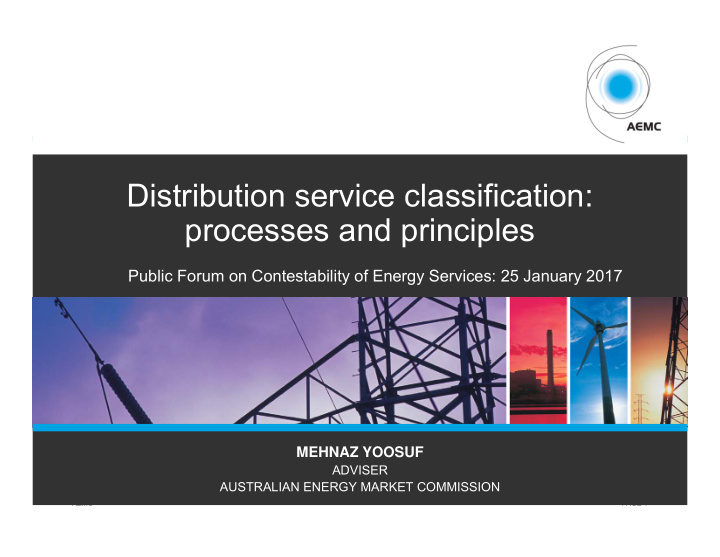



Distribution service classification: processes and principles Public Forum on Contestability of Energy Services: 25 January 2017 MEHNAZ YOOSUF ADVISER AUSTRALIAN ENERGY MARKET COMMISSION AEMC PAGE 1
Focus AEC focus COAG focus Regulation of economically regulated services Arrangements Issues across service Classification Service delivery classifications Transparency Capex vs opex of services discretion Procurement Shared assets Incentive Process RIT-D only mechanism mechanisms approach Solutions Expenditure Planning Definitions Cost allocation forecasts framework Binding Total Principles Ring-fencing RIT-D expenditure
Distribution service classification - process AEMC AEMC PAGE 3 PAGE 3
Distribution service classification: current process • AER undertakes distribution service classification during the framework and approach (F & A) stage of each DNSP’s regulatory determination. • AER typically publishes a draft framework and approach paper for consultation and then issues a final framework and approach paper. • AER may alter its service classification from the F&A in the draft revenue determination if it considers unforeseen circumstances arise. • Distribution determinations and framework approach processes occur on different timelines in different jurisdictions in the NEM. AEMC PAGE 4
COAG issues and solutions: guidelines and re- classification • COAG considers that the existing arrangements: – attract little engagement from stakeholders – create a lag in the ability of the AER to reclassify services • COAG considers that the Commission should consider changing the NER to: – require AER to publish a distribution service classification guideline; and – allow the AER to re-classify services within regulatory control periods. AEMC PAGE 5
Distribution service classification: definitions and principles AEMC AEMC PAGE 6 PAGE 6
Distribution service classification: stages Non-distribution Distribution services Level 1 services Negotiated Direct Unclassified distribution Level 2 control distribution services services services Standard Alternative Level 3 control control service service AEMC PAGE 7
Level one: definition of ‘distribution service’ • COAG and the AEC consider the definition of ‘distribution service’ (and its associated definitions) is unclear. • NER definition: ‘ A service provided by means of, or in connection with, a distribution system’. A ‘distribution system’ is defined as a ‘distribution network, together with the connection assets associated with the distribution network, which is connected to another transmission or distribution system’. • A key question in the Alternatives to Grid Supply rule change submitted by Western Power is whether ‘in connection with’ means there must be a physical connection with the distribution system in order for a service to be classified as a ‘distribution service’? AEMC PAGE 8
Level one reforms: definition of ‘distribution service’ • Commission’s power to make changes to this definition may be limited because of the extent and nature of related definitions under the NEL (such as 'electricity network service'). • We will be considering these matters in the context of these rule change requests and the Western Power rule change request. AEMC PAGE 9
Level two: current principles • Clause 6.2.1(c) of the NER: Factors the AER needs to have regard to in classifying distribution services: – the form of regulation factors; – the form of regulation (if any) previously applicable to the relevant service or services and, in particular, any previous classification under the present system of classification or under the previous regulatory system; – the desirability of consistency in the form of regulation for similar services; and – any other relevant factor. • Section 2F of NEL: Contains form of regulation factors. Includes consideration of extent and presence of barriers to entry, network externalities, availability of substitutes. AEMC PAGE 10
Level two: current principles • Clause 6.2.1(d) of the NER: In classifying distribution services previously subject to regulation, unless a different classification is clearly more appropriate: − there should be no departure from a previous classification (if service previously classified); and − the classification should be consistent with previously applicable regulatory approach (if no previous classification). AEMC PAGE 11
Level three: current principles • Clause 6.2.2(c) of the NER: Factors the AER must have regard to when classifying a ‘direct control service’ as a ‘standard control service’ or ‘alternative control service’. • Include the potential for development of competition in the market, the extent to which the costs of providing the service are directly attributable to the person to whom the service is provided. • Clause 6.2.2(d) of the NER: In classifying distribution services previously subject to regulation, unless a different classification is clearly more appropriate: – there should be no departure from a previous classification (if the service previously classified); and – the classification should be consistent with the previously applicable regulatory approach (if no previous classification). AEMC PAGE 12
Questions for stakeholders to consider Process • Is there a problem with the current process for distribution service classification? • Would a distribution service classification guideline increase clarity regarding distribution service classification? • To what extent does service classification being locked in over the regulatory control period create a lag in appropriate reclassification of services? • What would be the costs and benefits of allowing reclassification of services within a regulatory control period? AEMC PAGE 13
Questions for stakeholders to consider Level one • Does the definition of ‘distribution services’ provide clear guidance regarding which services are ‘distribution services’ and which are not? • What would be the pros and cons of changing the definition of ‘distribution services’? AEMC PAGE 14
Questions for stakeholders to consider Levels two and three • Do the form of regulation factors provide clear guidance to the AER in determining whether ‘distribution services’ should be classified as ‘direct control services’, ‘negotiated distribution services’ or ‘unclassified distribution services’? • Do the NER provide effective guidance to the AER in classifying ‘direct control services’ into ‘standard control services’ and ‘alternative control services’? • Should the requirement to not change service classification unless a new classification is clearly more appropriate be removed? AEMC PAGE 15
AEMC PAGE 16
Recommend
More recommend